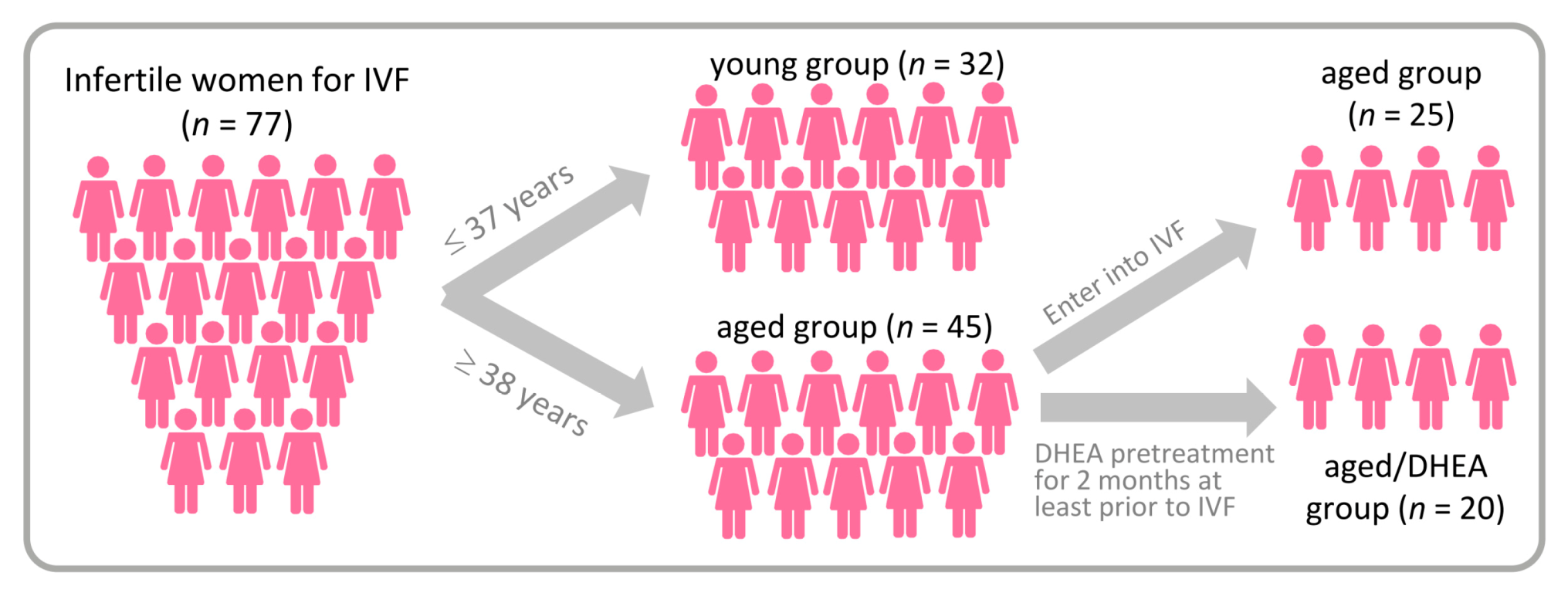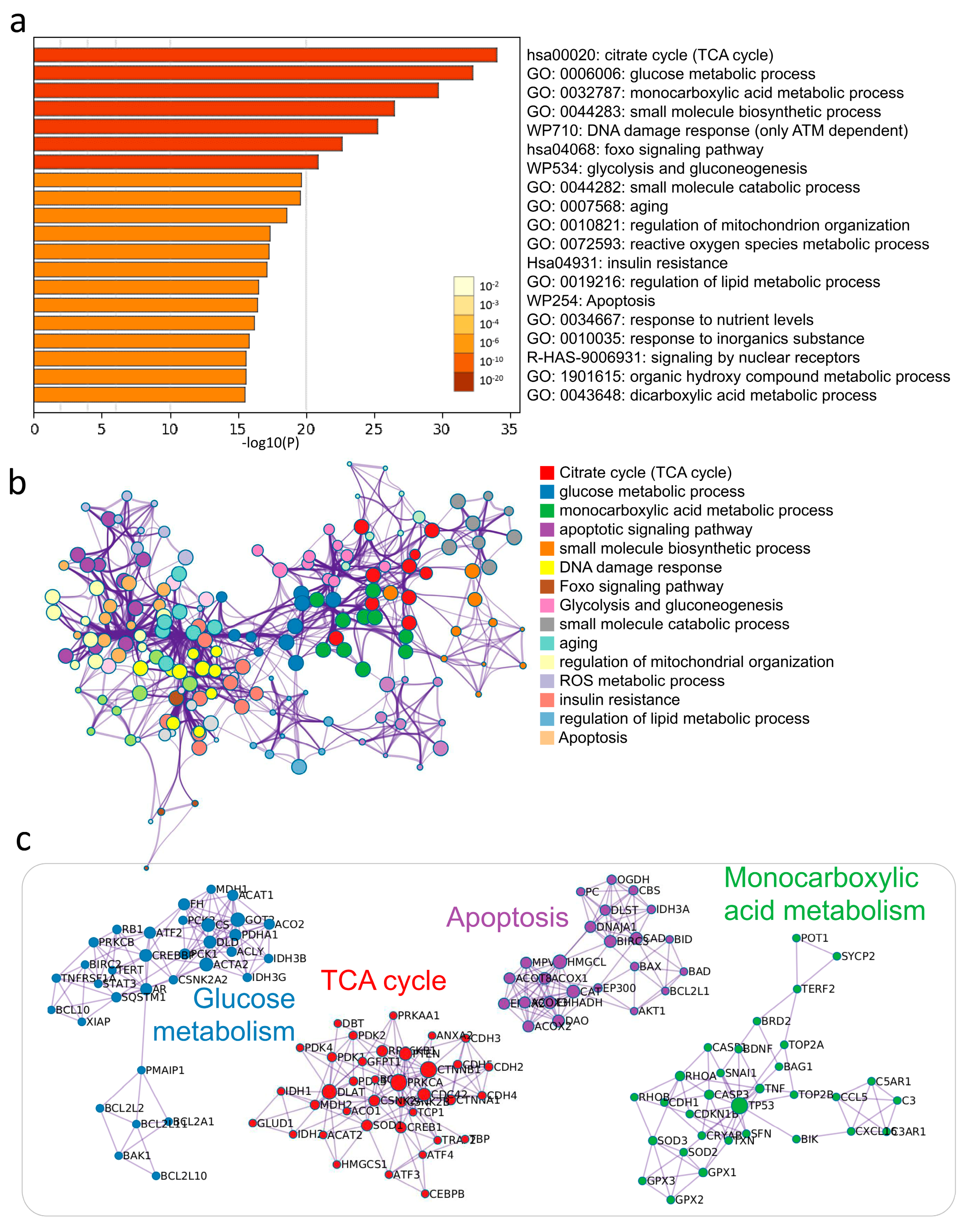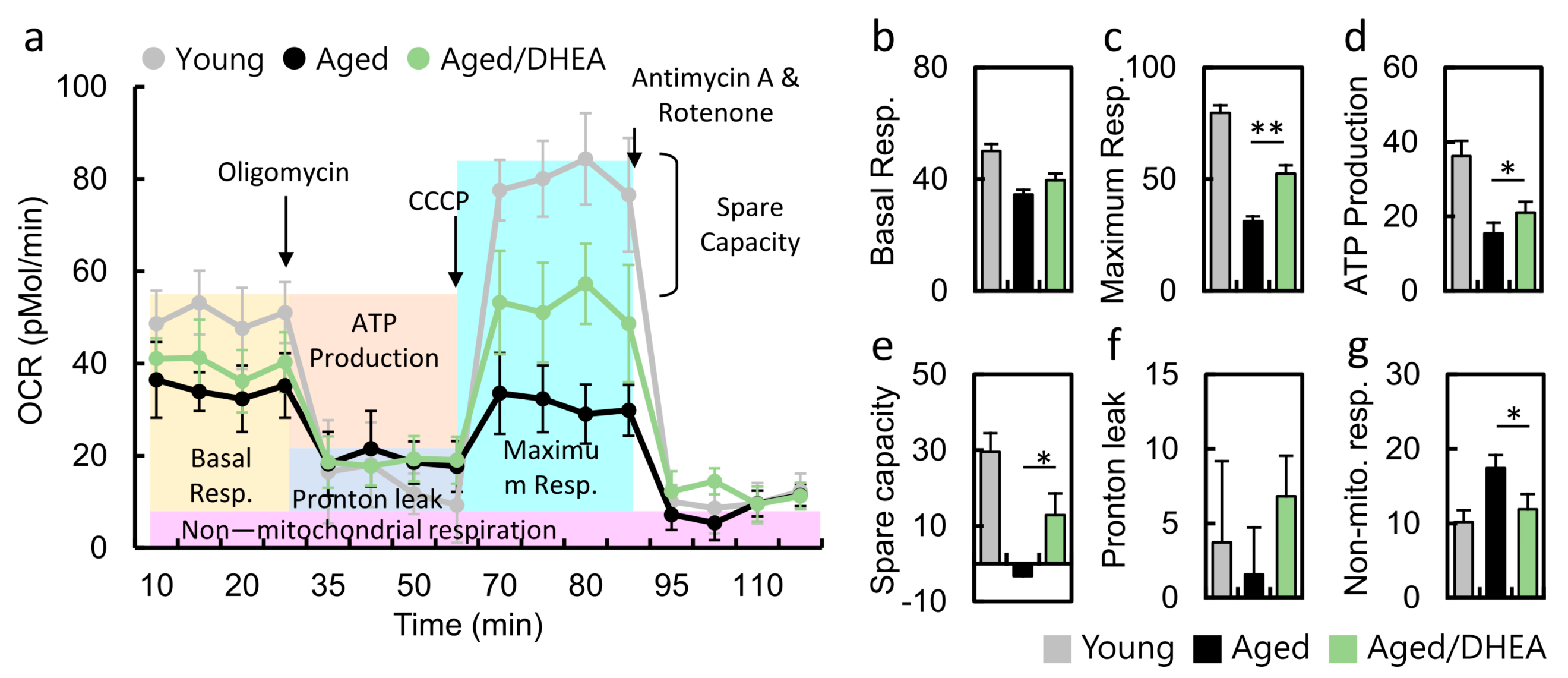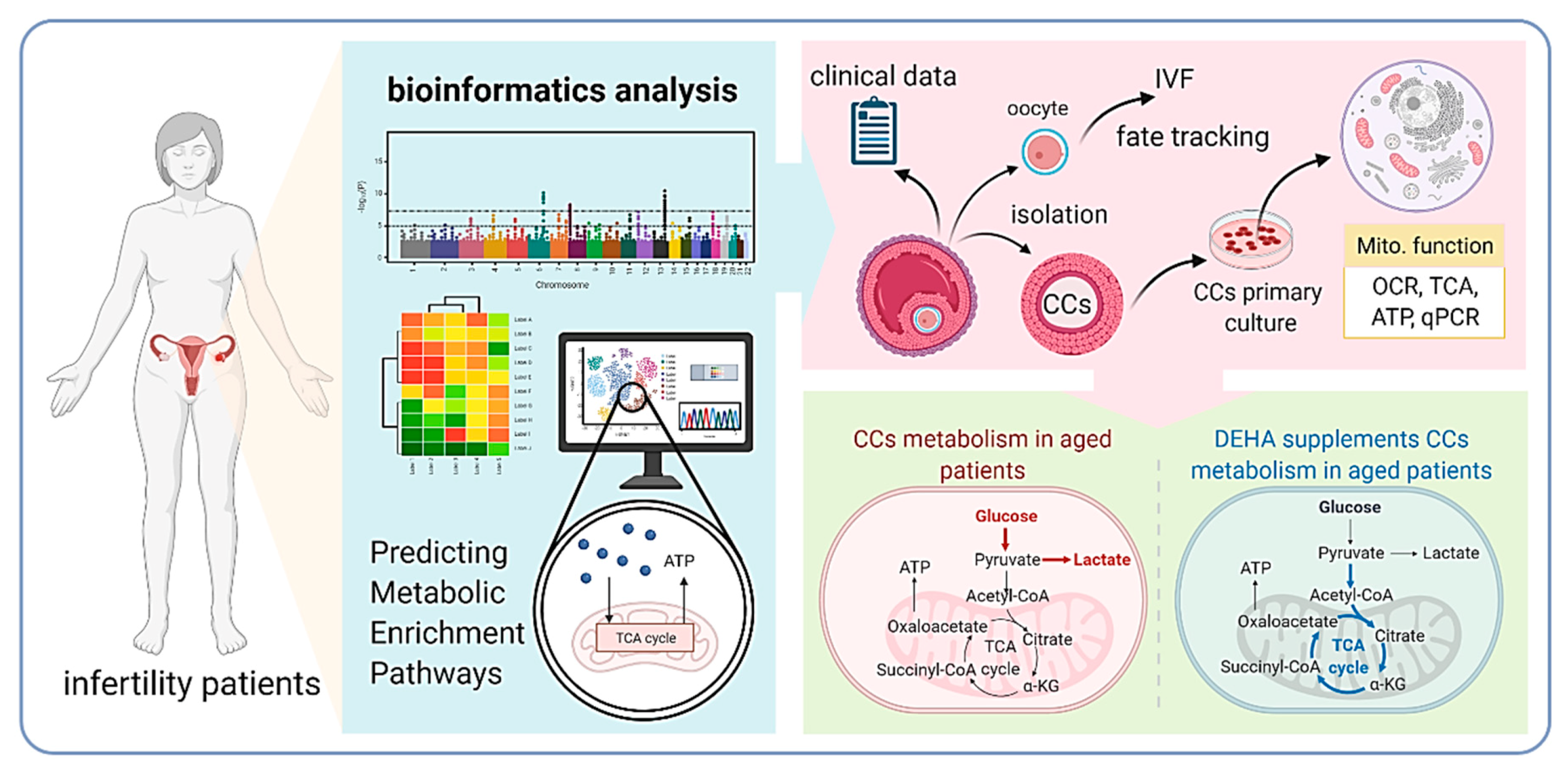Dehydroepiandrosterone Shifts Energy Metabolism to Increase Mitochondrial Biogenesis in Female Fertility with Advancing Age
Abstract
1. Introduction
2. Materials and Methods
2.1. Ethics Statement
2.2. Clinical Sample and Design
2.3. Collection of CCs from Patients
2.4. RNA Extraction and Real-Time PCR
2.5. Oxygen Consumption Rate Measurement
2.6. RNA Sequencing
2.7. Statistical Analysis
3. Results
3.1. Basic Characteristics of Patients Undergoing IVF Cycles
3.2. Cycle Characteristics and Clinical Outcomes of Patients Undergoing IVF Cycles
3.3. Enrichment Analysis of Key Modules of CCs by DHEA
3.4. DHEA Regulates Energy Production Pathways in Aging Cells
3.5. DHEA Normalizes the Decrease in the Oxygen Consumption Rate of Aged CCs
4. Discussion
5. Conclusions
Supplementary Materials
Author Contributions
Funding
Institutional Review Board Statement
Informed Consent Statement
Data Availability Statement
Conflicts of Interest
References
- Wellons, M.F.; Matthews, J.J.; Kim, C. Ovarian aging in women with diabetes: An overview. Maturitas 2017, 96, 109–113. [Google Scholar] [CrossRef] [PubMed]
- Lin, P.H.; Lin, L.T.; Li, C.J.; Kao, P.G.; Tsai, H.W.; Chen, S.N.; Wen, Z.H.; Wang, P.H.; Tsui, K.H. Combining Bioinformatics and Experiments to Identify CREB1 as a Key Regulator in Senescent Granulosa Cells. Diagnostics 2020, 10, 295. [Google Scholar] [CrossRef]
- Wen, J.; Wang, G.L.; Yuan, H.J.; Zhang, J.; Xie, H.L.; Gong, S.; Han, X.; Tan, J.H. Effects of glucose metabolism pathways on nuclear and cytoplasmic maturation of pig oocytes. Sci. Rep. 2020, 10, 2782. [Google Scholar] [CrossRef]
- Lubusky, M.; Prochazka, M.; Dhaifalah, I.; Horak, D.; Geierova, M.; Santavy, J. Fetal enterolithiasis: Prenatal sonographic and MRI diagnosis in two cases of urorectal septum malformation (URSM) sequence. Prenat. Diagn. 2006, 26, 345–349. [Google Scholar] [CrossRef]
- Tanghe, S.; Van Soom, A.; Nauwynck, H.; Coryn, M.; de Kruif, A. Minireview: Functions of the cumulus oophorus during oocyte maturation, ovulation, and fertilization. Mol. Reprod. Dev. 2002, 61, 414–424. [Google Scholar] [CrossRef]
- Herrick, J.R.; Lane, M.; Gardner, D.K.; Behboodi, E.; Memili, E.; Blash, S.; Echelard, Y.; Krisher, R.L. Metabolism, protein content, and in vitro embryonic development of goat cumulus-oocyte complexes matured with physiological concentrations of glucose and L-lactate. Mol. Reprod. Dev. 2006, 73, 256–266. [Google Scholar] [CrossRef]
- Harris, S.E.; Leese, H.J.; Gosden, R.G.; Picton, H.M. Pyruvate and oxygen consumption throughout the growth and development of murine oocytes. Mol. Reprod. Dev. 2009, 76, 231–238. [Google Scholar] [CrossRef]
- Downs, S.M. A gap-junction-mediated signal, rather than an external paracrine factor, predominates during meiotic induction in isolated mouse oocytes. Zygote 2001, 9, 71–82. [Google Scholar] [CrossRef] [PubMed]
- Kaneko, T.; Iuchi, Y.; Takahashi, M.; Fujii, J. Colocalization of polyol-metabolizing enzymes and immunological detection of fructated proteins in the female reproductive system of the rat. Histochem. Cell Biol. 2003, 119, 309–315. [Google Scholar] [CrossRef] [PubMed]
- Baulieu, E.E. Neurosteroids: A novel function of the brain. Psychoneuroendocrinology 1998, 23, 963–987. [Google Scholar] [CrossRef]
- Miller, W.L. Androgen biosynthesis from cholesterol to DHEA. Mol. Cell Endocrinol. 2002, 198, 7–14. [Google Scholar] [CrossRef]
- Keane, K.N.; Hinchliffe, P.M.; Namdar, N.; Conceicao, J.L.; Newsholme, P.; Yovich, J.L. Novel dehydroepiandrosterone troche supplementation improves the serum androgen profile of women undergoing in vitro fertilization. Drug Des. Dev. Ther. 2015, 9, 5569–5578. [Google Scholar] [CrossRef] [PubMed]
- Zhang, H.H.; Xu, P.Y.; Wu, J.; Zou, W.W.; Xu, X.M.; Cao, X.Y.; Wei, L.Z. Dehydroepiandrosterone improves follicular fluid bone morphogenetic protein-15 and accumulated embryo score of infertility patients with diminished ovarian reserve undergoing in vitro fertilization: A randomized controlled trial. J. Ovarian Res. 2014, 7, 93. [Google Scholar] [CrossRef]
- Gleicher, N.; Barad, D.H. Dehydroepiandrosterone (DHEA) supplementation in diminished ovarian reserve (DOR). Reprod. Biol. Endocrinol. 2011, 9, 67. [Google Scholar] [CrossRef] [PubMed]
- Magri, F.; Cravello, L.; Barili, L.; Sarra, S.; Cinchetti, W.; Salmoiraghi, F.; Micale, G.; Ferrari, E. Stress and dementia: The role of the hypothalamicpituitary-adrenal axis. Aging Clin. Exp. Res. 2006, 18, 167–170. [Google Scholar] [CrossRef]
- Ohlsson, C.; Labrie, F.; Barrett-Connor, E.; Karlsson, M.K.; Ljunggren, O.; Vandenput, L.; Mellstrom, D.; Tivesten, A. Low serum levels of dehydroepiandrosterone sulfate predict all-cause and cardiovascular mortality in elderly Swedish men. J. Clin. Endocrinol. Metab. 2010, 95, 4406–4414. [Google Scholar] [CrossRef]
- Phillips, A.C.; Carroll, D.; Gale, C.R.; Lord, J.M.; Arlt, W.; Batty, G.D. Cortisol, DHEA sulphate, their ratio, and all-cause and cause-specific mortality in the Vietnam Experience Study. Eur. J. Endocrinol. 2010, 163, 285–292. [Google Scholar] [CrossRef] [PubMed]
- Li, C.J.; Chen, S.N.; Lin, L.T.; Chern, C.U.; Wang, P.H.; Wen, Z.H.; Tsui, K.H. Dehydroepiandrosterone Ameliorates Abnormal Mitochondrial Dynamics and Mitophagy of Cumulus Cells in Poor Ovarian Responders. J. Clin. Med. 2018, 7, 293. [Google Scholar] [CrossRef]
- Li, C.J.; Lin, H.Y.; Ko, C.J.; Lai, J.C.; Chu, P.Y. A Novel Biomarker Driving Poor-Prognosis Liver Cancer: Overexpression of the Mitochondrial Calcium Gatekeepers. Biomedicines 2020, 8, 451. [Google Scholar] [CrossRef]
- Chen, Y.C.; Li, J.Y.; Li, C.J.; Tsui, K.H.; Wang, P.H.; Wen, Z.H.; Lin, L.T. Luteal Phase Ovarian Stimulation versus Follicular Phase Ovarian Stimulation results in different Human Cumulus cell genes expression: A pilot study. Int. J. Med. Sci. 2021, 18, 1600–1608. [Google Scholar] [CrossRef]
- Sonmezer, M.; Ozmen, B.; Cil, A.P.; Ozkavukcu, S.; Tasci, T.; Olmus, H.; Atabekoglu, C.S. Dehydroepiandrosterone supplementation improves ovarian response and cycle outcome in poor responders. Reprod. Biomed. Online 2009, 19, 508–513. [Google Scholar] [CrossRef]
- Sen, A.; Hammes, S.R. Granulosa cell-specific androgen receptors are critical regulators of ovarian development and function. Mol. Endocrinol. 2010, 24, 1393–1403. [Google Scholar] [CrossRef]
- Xie, M.; Zhong, Y.; Xue, Q.; Wu, M.; Deng, X.; Santos, H.O.; Tan, S.C.; Kord-Varkaneh, H.; Jiao, P. Impact of dehydroepianrosterone (DHEA) supplementation on serum levels of insulin-like growth factor 1 (IGF-1): A dose-response meta-analysis of randomized controlled trials. Exp. Gerontol. 2020, 136, 110949. [Google Scholar] [CrossRef]
- Nielsen, M.E.; Rasmussen, I.A.; Kristensen, S.G.; Christensen, S.T.; Mollgard, K.; Wreford Andersen, E.; Byskov, A.G.; Yding Andersen, C. In human granulosa cells from small antral follicles, androgen receptor mRNA and androgen levels in follicular fluid correlate with FSH receptor mRNA. Mol. Hum. Reprod. 2011, 17, 63–70. [Google Scholar] [CrossRef] [PubMed]
- Gleicher, N.; Weghofer, A.; Barad, D.H. Dehydroepiandrosterone (DHEA) reduces embryo aneuploidy: Direct evidence from preimplantation genetic screening (PGS). Reprod. Biol. Endocrinol. 2010, 8, 140. [Google Scholar] [CrossRef]
- Yi, X.; Maeda, N. Endogenous production of lipoic acid is essential for mouse development. Mol. Cell Biol. 2005, 25, 8387–8392. [Google Scholar] [CrossRef] [PubMed]
- Lagouge, M.; Argmann, C.; Gerhart-Hines, Z.; Meziane, H.; Lerin, C.; Daussin, F.; Messadeq, N.; Milne, J.; Lambert, P.; Elliott, P.; et al. Resveratrol improves mitochondrial function and protects against metabolic disease by activating SIRT1 and PGC-1alpha. Cell 2006, 127, 1109–1122. [Google Scholar] [CrossRef]
- Moawad, A.R.; Xu, B.; Tan, S.L.; Taketo, T. l-carnitine supplementation during vitrification of mouse germinal vesicle stage-oocytes and their subsequent in vitro maturation improves meiotic spindle configuration and mitochondrial distribution in metaphase II oocytes. Hum. Reprod. 2014, 29, 2256–2268. [Google Scholar] [CrossRef] [PubMed]
- Ben-Meir, A.; Burstein, E.; Borrego-Alvarez, A.; Chong, J.; Wong, E.; Yavorska, T.; Naranian, T.; Chi, M.; Wang, Y.; Bentov, Y.; et al. Coenzyme Q10 restores oocyte mitochondrial function and fertility during reproductive aging. Aging Cell 2015, 14, 887–895. [Google Scholar] [CrossRef]
- Tsui, K.H.; Wang, P.H.; Lin, L.T.; Li, C.J. DHEA protects mitochondria against dual modes of apoptosis and necroptosis in human granulosa HO23 cells. Reproduction 2017, 154, 101–110. [Google Scholar] [CrossRef]
- Wu, X.; Li, F.; Wang, X.; Li, C.; Meng, Q.; Wang, C.; Huang, J.; Chen, S.; Zhu, Z. Antibiotic bedaquiline effectively targets growth, survival and tumor angiogenesis of lung cancer through suppressing energy metabolism. Biochem. Biophys. Res. Commun. 2018, 495, 267–272. [Google Scholar] [CrossRef] [PubMed]
- Lin, L.T.; Wang, P.H.; Wen, Z.H.; Li, C.J.; Chen, S.N.; Tsai, E.M.; Cheng, J.T.; Tsui, K.H. The Application of Dehydroepiandrosterone on Improving Mitochondrial Function and Reducing Apoptosis of Cumulus Cells in Poor Ovarian Responders. Int. J. Med. Sci. 2017, 14, 585–594. [Google Scholar] [CrossRef]
- Lin, L.T.; Cheng, J.T.; Wang, P.H.; Li, C.J.; Tsui, K.H. Dehydroepiandrosterone as a potential agent to slow down ovarian aging. J. Obstet. Gynaecol. Res. 2017, 43, 1855–1862. [Google Scholar] [CrossRef] [PubMed]
- Prough, R.A.; Clark, B.J.; Klinge, C.M. Novel mechanisms for DHEA action. J. Mol. Endocrinol. 2016, 56, R139–R155. [Google Scholar] [CrossRef] [PubMed]





| Parameters | Young (≤37) (n = 32) | Aged (≥38) (n = 25) | Aged/DHEA (n = 20) |
|---|---|---|---|
| Age (years) | 35.7 ± 4.1 | 41.3 ± 3.4 * | 40.8 ± 2.7 * |
| BMI (kg/m2) | 22.7 ± 2.6 | 23.1 ± 2.9 | 24.7 ± 3.1 |
| Duration of infertility (years) | 3.6 ± 1.9 | 2.8 ± 2.4 | 3.0 ± 3.5 |
| Previous IVF failure (n) | 1.2 ± 1.4 | 1.4 ± 2.1 | 3.4 ± 2.7 *# |
| Types of infertility n (%) | |||
| Primary infertility | 16/32 (50%) | 12/25 (48%) | 10/20 (50%) |
| Secondary infertility | 18/32 (56%) | 12/25 (48%) | 9/20 (45%) |
| Basal FSH (IU/l) | 4.7 ± 2.5 | 5.8 ± 5.1 | 5.5 ± 4.2 |
| Basal E2 (pg/mL) | 91.2 ± 67.5 | 107.1 ± 62.8 | 94.6 ± 77.2 |
| Basal LH (IU/l) | 4.9 ± 2.8 | 4.2 ± 3.3 | 5.3 ± 4.3 |
| Parameters | Young (n = 32) | Aged (n = 25) | Aged/DHEA (n = 20) |
|---|---|---|---|
| Stimulation duration (days) | 10.2 ± 1.1 | 10.7 ± 2.9 | 10.4 ± 1.8 |
| HMG/FSH dose (IU) | 3040.3 ± 660.1 | 2836.3 ± 812.2 | 2982.1 ± 604.1 |
| No. of oocytes retrieved (n) | 8.7 ± 4.1 | 3.2 ± 2.1 * | 5.2 ± 1.4 *# |
| No. of metaphase II oocytes (n) | 6.4 ± 3.2 | 1.8 ± 1.7 * | 2.3 ± 1.5 * |
| Maturation rate (%) | 60.7 ± 22.1 | 48.1 ± 32.0 * | 62.5 ± 42.1 |
| No. of fertilized oocytes (n) | 8.3 ± 2.4 | 2.5 ± 1.4 * | 2.8 ± 1.9 * |
| Fertilization rate (%) | 71.3 ± 18.6 | 67.8 ± 21.2 | 71.7 ± 22.0 |
| No. of Day 3 embryos (n) | 6.6 ± 3.3 | 1.7 ± 2.1 * | 3.4 ± 1.6 *# |
| No. of top-quality D3 embryos (n) | 3.1 ± 2.1 | 0.7 ± 1.2 * | 2.4 ± 1.7 *# |
| Clinical pregnancy rate % (n) | 53.1% (17/32) | 16.0% (4/25) | 26.3% (6/20) |
| Ongoing pregnancy rate % (n) | 50.0% (16/32) | 16.0% (4/25) | 26.3% (6/20) |
| Live birth rate % (n) | 50.0% (16/32) | 12.0% (3/25) | 16.7% (4/20) |
Publisher’s Note: MDPI stays neutral with regard to jurisdictional claims in published maps and institutional affiliations. |
© 2021 by the authors. Licensee MDPI, Basel, Switzerland. This article is an open access article distributed under the terms and conditions of the Creative Commons Attribution (CC BY) license (https://creativecommons.org/licenses/by/4.0/).
Share and Cite
Li, C.-J.; Lin, L.-T.; Tsui, K.-H. Dehydroepiandrosterone Shifts Energy Metabolism to Increase Mitochondrial Biogenesis in Female Fertility with Advancing Age. Nutrients 2021, 13, 2449. https://doi.org/10.3390/nu13072449
Li C-J, Lin L-T, Tsui K-H. Dehydroepiandrosterone Shifts Energy Metabolism to Increase Mitochondrial Biogenesis in Female Fertility with Advancing Age. Nutrients. 2021; 13(7):2449. https://doi.org/10.3390/nu13072449
Chicago/Turabian StyleLi, Chia-Jung, Li-Te Lin, and Kuan-Hao Tsui. 2021. "Dehydroepiandrosterone Shifts Energy Metabolism to Increase Mitochondrial Biogenesis in Female Fertility with Advancing Age" Nutrients 13, no. 7: 2449. https://doi.org/10.3390/nu13072449
APA StyleLi, C.-J., Lin, L.-T., & Tsui, K.-H. (2021). Dehydroepiandrosterone Shifts Energy Metabolism to Increase Mitochondrial Biogenesis in Female Fertility with Advancing Age. Nutrients, 13(7), 2449. https://doi.org/10.3390/nu13072449








